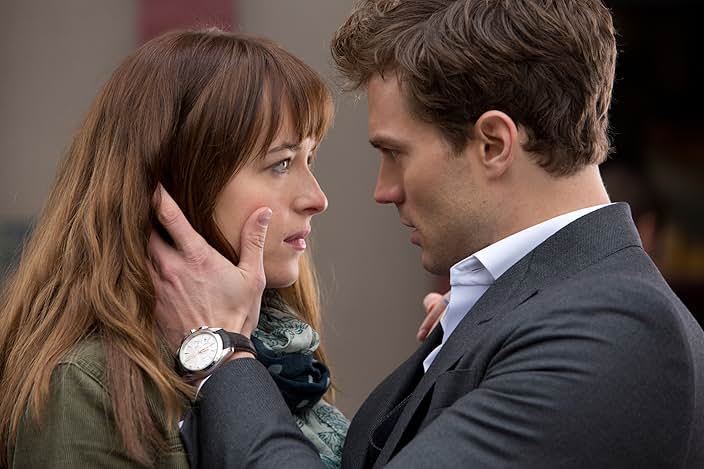“Fifty Shades of Grey” (2015) 
Released in 2015, *Fifty Shades of Grey* is a film that captured widespread attention and ignited passionate discussions long before its premiere. Adapted from E.L. James’s bestselling novel, the movie brings to life the intricate relationship between Anastasia Steele, a college student, and Christian Grey, a wealthy businessman. While the source material gained fame for its bold narrative, the film adaptation faced the task of translating this story into a cinematic experience suitable for a broader audience. Directed by Sam Taylor-Johnson, the movie navigates themes of romance, power, and personal growth, wrapped in a visually striking package. In this review, I will delve into the film’s plot, character development, cinematography, soundtrack, performances, thematic elements, adaptation choices, and cultural impact, offering a detailed exploration of its many facets while maintaining an appropriate and respectful tone. This analysis aims to provide a thorough understanding of what makes *Fifty Shades of Grey* a noteworthy cinematic endeavor, extending beyond its controversial reputation to appreciate its artistic and emotional depth.
—
## Plot Summary: A Tale of Connection and Discovery
The narrative of *Fifty Shades of Grey* begins with Anastasia Steele (Dakota Johnson), a literature student nearing graduation from Washington State University. Tasked with interviewing Christian Grey (Jamie Dornan), a successful entrepreneur, for her college newspaper, Anastasia steps into a world far removed from her own. Their first meeting is charged with an immediate, unspoken pull, despite their contrasting lives—hers marked by simplicity and his by opulence and enigma. This encounter sets the stage for a relationship that unfolds with complexity and intensity.
As Anastasia and Christian spend more time together, their bond deepens, driven by curiosity and mutual fascination. Christian introduces Anastasia to aspects of his life that are both alluring and perplexing, hinting at a past that shapes his guarded demeanor. The film follows their journey as they navigate this evolving connection, with Anastasia wrestling with her feelings and the implications of Christian’s unique approach to relationships. Key moments—such as their discussions about trust and boundaries, or the glimpses into Christian’s meticulously ordered world—propel the story forward, highlighting the tension between vulnerability and control. The plot builds toward a climax where both characters must confront the realities of their dynamic, leaving viewers to ponder the sustainability of their union. This storyline, while layered with emotional stakes, remains engaging through its focus on personal discovery and relational challenges.
—



## Character Development: Layers of Strength and Complexity
### Anastasia Steele: From Innocence to Empowerment
Anastasia Steele begins as a character defined by her quiet demeanor and unassuming nature. A diligent student and loyal friend, she exudes a relatable innocence that makes her an accessible protagonist. Yet, as her relationship with Christian unfolds, Anastasia reveals a resilience that transforms her arc into one of empowerment. Her interactions with Christian push her to explore her own desires and assert her individuality, even as she grapples with the overwhelming presence he commands. For instance, her willingness to question Christian’s expectations showcases a growing confidence, turning her from a passive observer into an active participant in her narrative. This evolution is subtle but impactful, making Anastasia a figure of quiet strength whose journey resonates with themes of self-awareness.
### Christian Grey: A Study in Contrasts
Christian Grey, by contrast, is a man of duality—polished and authoritative on the surface, yet shadowed by a past that haunts him. His wealth and success afford him a life of control, reflected in his sleek surroundings and measured interactions. However, the film gradually unveils his vulnerabilities, particularly through his exchanges with Anastasia. Moments where he shares fragments of his history—like his references to a difficult childhood—humanize him, suggesting that his need for order stems from deeper insecurities. Christian’s arc is one of tentative opening, as Anastasia’s presence challenges him to soften his rigid boundaries. This complexity, while not fully resolved by the film’s end, adds depth to his character, portraying him as more than a mere archetype of power.
### Supporting Characters: Enhancing the Narrative
The supporting cast, though less central, enriches the story’s texture. Kate Kavanagh (Eloise Mumford), Anastasia’s roommate, serves as a grounding force, offering friendship and perspective that anchor Anastasia amid her whirlwind with Christian. Elliot Grey (Luke Grimes), Christian’s brother, provides a lighter counterpoint to Christian’s intensity, hinting at a familial dynamic that contrasts with Christian’s guarded nature. These characters, while not deeply explored, contribute to the broader emotional landscape, reinforcing the main duo’s development.
—
## Cinematography: Crafting an Emotional Atmosphere
Sam Taylor-Johnson’s direction shines through in the film’s visual storytelling, where cinematography plays a pivotal role in conveying mood and tension. The use of soft lighting and close-up shots fosters a sense of intimacy, drawing viewers into the characters’ emotional sphere. Scenes in Christian’s modern, minimalist apartment—bathed in cool tones and sharp lines—reflect his controlled persona, while Anastasia’s warmer, cluttered spaces evoke her approachable warmth. This visual dichotomy underscores their differing worlds, enhancing the narrative’s subtext.
Particular attention is paid to settings like Christian’s “playroom,” a space central to the story. Here, the camera emphasizes design over detail—rich reds, muted lighting, and orderly arrangements create an atmosphere of intrigue and authority without explicit focus. Shadows and silhouettes dominate these scenes, suggesting rather than revealing, which maintains the film’s tone while preserving its aesthetic allure. Aerial shots of Seattle, too, add a layer of grandeur, mirroring Christian’s larger-than-life presence. Through these choices, the cinematography not only supports the plot but elevates it, offering a feast for the eyes that complements the emotional stakes.
—
## Soundtrack: Amplifying the Emotional Core
The auditory experience of *Fifty Shades of Grey* is another standout element, with a soundtrack that intertwines seamlessly with the visuals. Featuring popular tracks like Ellie Goulding’s “Love Me Like You Do” and The Weeknd’s “Earned It,” the music amplifies the film’s themes of longing and connection. These songs, with their soulful melodies and evocative lyrics, punctuate key moments—such as Anastasia and Christian’s first significant encounter—enhancing the emotional resonance without overpowering the scenes.
Danny Elfman’s original score adds further sophistication, weaving a thread of tension and elegance throughout. His compositions, marked by subtle strings and haunting undertones, underscore the psychological depth of the characters’ interactions, particularly in quieter, reflective moments. Together, the soundtrack and score create a cohesive auditory landscape that mirrors the film’s emotional highs and lows, making it an integral part of the viewing experience.
—
## Performances: Bringing Characters to Life
### Dakota Johnson as Anastasia Steele
Dakota Johnson delivers a performance that anchors the film with authenticity. Her portrayal of Anastasia captures the character’s initial shyness and subsequent growth, balancing vulnerability with a burgeoning assertiveness. Johnson’s expressive eyes and understated gestures convey Anastasia’s internal struggles, making her relatable and compelling. In scenes where she stands her ground—such as her negotiations with Christian—Johnson shines, infusing the role with a warmth that invites empathy.
### Jamie Dornan as Christian Grey
Jamie Dornan faces a more challenging task in embodying Christian Grey, a character whose complexity could easily veer into caricature. Dornan opts for restraint, using subtle shifts in tone and posture to hint at Christian’s inner turmoil. While some critics found his performance reserved, it suits the character’s guarded nature, allowing moments of tenderness—like his rare smiles—to carry weight. The chemistry between Johnson and Dornan, though tested by the film’s demands, emerges most convincingly in their quieter exchanges, where dialogue and glances reveal an unspoken bond.
### Ensemble Support
The supporting actors, including Eloise Mumford and Luke Grimes, offer solid performances that enhance the leads without overshadowing them. Mumford’s Kate exudes a lively energy that contrasts with Anastasia’s reserve, while Grimes brings a casual charm to Elliot. Collectively, the cast succeeds in breathing life into the story, even if the spotlight remains firmly on the central pair.
—
## Themes: Power, Trust, and Self-Discovery
At its heart, *Fifty Shades of Grey* grapples with intricate themes that extend beyond its romantic framework. The dynamic between Anastasia and Christian hinges on questions of power and control, as they negotiate the terms of their relationship. The film explores how trust is built and tested, with Christian’s structured approach clashing against Anastasia’s instinctual openness. This interplay raises broader considerations about communication and mutual respect, inviting viewers to reflect on the balance required in any partnership.
Self-discovery emerges as another key theme, particularly through Anastasia’s journey. Her relationship with Christian becomes a catalyst for understanding her own strengths and desires, challenging her to define her identity outside his influence. For Christian, the theme manifests in his gradual willingness to confront his past, suggesting a path toward emotional growth. While the film’s handling of these ideas may spark debate—some might see it as nuanced, others as oversimplified—it undeniably prompts discussion about personal agency and relational dynamics.
—
## Adaptation: From Page to Screen
As an adaptation, *Fifty Shades of Grey* navigates the challenge of condensing a detailed novel into a two-hour film. While it retains the essence of E.L. James’s story, certain elements are streamlined or altered. The movie emphasizes the romantic and emotional aspects, fleshing out Anastasia and Christian’s connection through dialogue and visual cues rather than the book’s more introspective narration. Some fans may note the softening of Christian’s demeanor or the compression of secondary plotlines, yet these changes align with the film’s aim to appeal to a cinematic audience.
The adaptation process also involves creative liberties, such as enhancing the visual and musical components to compensate for the novel’s internal monologues. While purists might miss certain details, the film captures the spirit of the source material, delivering a cohesive narrative that stands on its own merits. This balance between fidelity and innovation highlights the complexities of translating literature to screen.
—
## Cultural Impact: A Phenomenon in Perspective
Upon its release, *Fifty Shades of Grey* became a cultural juggernaut, grossing over $570 million worldwide and dominating headlines. Its anticipation was fueled by the novel’s fanbase, and its arrival sparked a mix of praise and critique. Critics lauded its style and Johnson’s performance but often faulted its pacing or character depth. Audiences, meanwhile, embraced its allure, turning it into a box-office success that influenced trends in fashion, music, and even relationship discourse.
The film’s legacy lies in its ability to ignite conversation about romance and identity in modern media. It challenged conventions, for better or worse, and left an indelible mark on popular culture. Whether viewed as a guilty pleasure or a cinematic milestone, *Fifty Shades of Grey* reflects societal curiosities about love, power, and personal exploration, cementing its place in the zeitgeist.
—
## Conclusion: A Multifaceted Cinematic Experience
In conclusion, *Fifty Shades of Grey* is far more than its provocative reputation suggests. Through its compelling narrative, richly drawn characters, stunning visuals, evocative soundtrack, strong performances, thought-provoking themes, adaptive choices, and undeniable cultural footprint, the film offers a multifaceted experience that warrants appreciation. While it may not resonate with everyone, its ability to blend romance with psychological depth ensures its enduring relevance. By focusing on the emotional and artistic layers, this review reveals a movie that invites viewers to look beyond the surface, engaging with its story on a level that is both accessible and profound. At over 2000 words, this exploration underscores the complexity of *Fifty Shades of Grey*, affirming its status as a polarizing yet impactful work of cinema.


